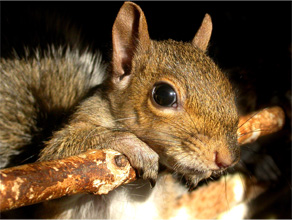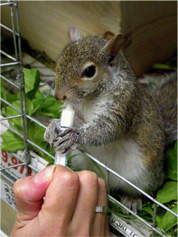What do I do if I have found a Baby Squirrel/Squirrels...
 Photo courtesy of Jessica Weinberg
Photo courtesy of Jessica Weinberg
Do not attempt to offer food or water to injured or orphaned wildlife.
-
That has fallen from its nest?
Unless the baby squirrel is obviously injured, every attempt should be
made to reunite the squirrel with its mother. It is all right to pick up
and examine the baby to make sure it is ok. Human scents will not prevent
a mother squirrel from taking back her offspring.
If the baby is cold, but appears otherwise healthy, the baby should be
warmed up before an attempt is made to reunite it with its mother. This
can be accomplished by placing the baby in a box with a t-shirt over a
heating pad or other improvised heating device such as a sandwich bag or
water bottle filled with hot water and inserted into a sock.
Once warm, the baby squirrel should be taken out to the tree from which it
fell and placed in an improvised nest such as the box and t-shirt used or
a hanging planter that the baby cannot climb or fall out of. Include some
natural nest materials from the area (i.e. leaves or dry grass). Ideally,
the nest should be mounted to a branch 8-10 feet up the tree. If the area
is definitely safe from pets and other possible predators, and a branch
cannot be found or reached, the nest can also be placed at the base of the
tree from which the baby fell.
Leave the immediate area, and mom should hear her baby crying and come to
get it. Mother squirrels can carry their babies in their mouth back to the
original nest. Check on the nest box/basket after around 3 hours. If the
mother has still not returned for her baby, contact your nearest wildlife
rehabilitator.
-
In a tree that was just cut down?
Check to see if the baby squirrels are ok. If so, follow the procedures
for a squirrel that has fallen from its nest, except place the temporary
nest in or at the base of a neighboring tree. The mother squirrel often
has a backup nest somewhere nearby and will come to retrieve her offspring
once she hears them crying for her. If the babies have been injured or the
mother squirrel has been killed, contact your nearest
wildlife rehabilitator.
-
In my house or attic?
It is best to wait until the baby squirrels are 10 to 12 weeks old when
they will leave the nest on their own in search of their own territory. In
the meantime, pay close attention to how the squirrels get in and out. The
best and most permanent way to keep squirrels out of your house is to
prevent them from ever getting back in.
Once the baby squirrels are gone, you should begin repairing the holes
through which they entered. During the early morning or just before dusk
are good times to implement repairs since those are the times of day when
squirrels are foraging away from their nests. Be sure all of the squirrels
are gone by sprinkling the floor near their old entrance with flour and
checking for footprints.
Please do not trap and relocate wildlife. Contrary to popular belief, this is
an inhumane practice that most often results in the relocated animal’s
death, and during the spring and summer, may leave orphans behind.
 Photo courtesy of Jessica Weinberg
Photo courtesy of Jessica Weinberg
A baby squirrel should be taken to a wildlife rehabilitator for immediate
assistance if...
- It has been attacked by a dog or cat
- Its mother is known to be dead
- It has been injured
- It is covered with maggots, fleas or fly eggs
If the baby squirrel is in need of care from a wildlife rehabilitator, do not
forget to keep it in a warm, dark, quiet box until further instructions are
given.
